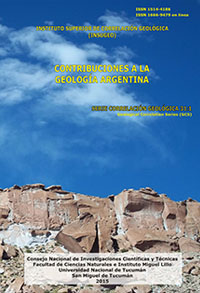Serie Correlación Geológica 31 (1)
Caracterización petrográfica, geoquímica y edad U-Pb (ID-TIMS) de la Formación Espinal cerca del límite de Sierras Pampeanas con la Precordillera de Jagüé, La Rioja (Argentina)
Paula Verónica Frigerio | Carlos A. Cingolani | Miguel Angelo Stipp Basei
Descargar trabajo en formato PDFResumen
LA FORMACIÓN ESPINAL EN LOS AFLORAMIENTOS CERCANOS AL LÍMITE NORTE DE SIERRAS PAMPEANAS CON LA PRECORDILLERA DE JAGÜÉ, LA RIOJA (ARGENTINA). Se analizan los afloramientos de la Formación Espinal en el margen occidental de la Sierra de Toro Negro, al norte del Bolsón de Jagüé, La Rioja, cerca del límite tectónico con los afloramientos de la denominada Precordillera de Jagüé. Esta unidad corresponde al basamento de medio a alto grado de Sierras Pampeanas Occidentales. Se presentan datos de petrografía, geoquímica y una edad U-Pb TIMS en circones detríticos de 905 +14/-13 Ma, (MSWD = 0,74; discordia) ligeramente más joven que otras edades obtenidas para esta unidad pero aun comparables con las del ciclo Grenvilliano. Las litologías predominantes son gneises y esquistos anfibólicos, granatíferos y biotíticos con evidencias de retrogradación. La composición y textura de las muestras son coherentes con un origen sedimentario e ígneo para estos afloramientos.Estas rocas se distinguen de aquellas del basamento de la Precordillera-Cuyania principalmente por el mayor grado metamórfico.
Abstract
THE ESPINAL FORMATION IN THE OUTCROPS NEAR THE NORTHERN LIMIT WITHIN THE PAMPEAN RANGES AND THE PRECORDILLERA OF JAGÜÉ, LA RIOJA (ARGENTINA).The outcrops of the Espinal Formation in the western margin of the Toro Negro Range, north of the Bolsón de Jagüé, La Rioja, near the tectonic limit with the outcrop of the Precordillera of Jagüé are analyzed. This unit corresponds to the medium to high grade metamorphic basement of the Western Pampean Ranges. Petrography, geochemistry and a U-Pb TIMS age on detrital circóns of 905 +14/-13 Ma, (MSWD = 0,74; discordia)are presented. This age is slightly younger than others obtained for this unit but still comparable with the Grenvillian cicle. The dominant lithologies are amphibolic, granatiferous and biotitic gneises and schists with evidences of retrogradation. The composition and texture of the samples points to a sedimentary and igneous origin for these outcrops. These rocks distinguishes from the ones that forms the basement of the Precordillera-Cuyania, mainly because the higher metamorphic grade.






